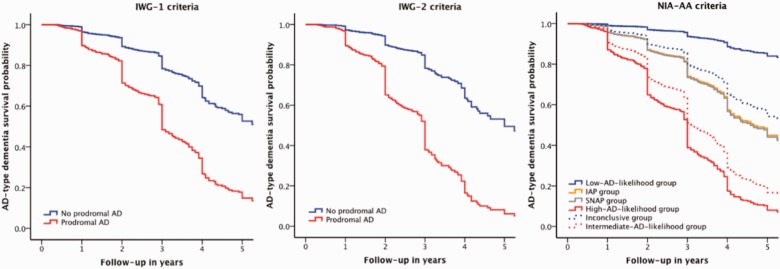Figure 1.
Alzheimer’s disease-type dementia survival probability by the IWG-1, IWG-2 and NIA-AA criteria. The graphs represent the Alzheimer’s disease-type dementia survival probability according to the IWG-1 (left), IWG-2 (middle), and NIA-AA (right) criteria, adjusted for age, gender, education and centre. IWG-1: The group without prodromal Alzheimer’s disease represents subjects without memory impairment and/or abnormal biomarker(s). The prodromal Alzheimer’s disease group represents subjects with memory impairment and at least one abnormal biomarker. IWG-2: The group without prodromal Alzheimer’s disease represents subjects with normal CSF amyloid-β1-42 and/or tau. The prodromal Alzheimer’s disease group represents subjects with abnormal CSF amyloid-β1-42 and tau. NIA-AA: The low Alzheimer’s disease likelihood group represents subjects with normal amyloid and neuronal injury markers, the high Alzheimer’s disease likelihood group represents subjects with both abnormal amyloid and neuronal injury markers, the IAP group is a conflicting biomarker group with an abnormal amyloid marker and normal neuronal injury marker, the SNAP group is a conflicting biomarker group with an abnormal neuronal injury marker and normal amyloid marker, the intermediate Alzheimer’s disease likelihood group represents subjects with an abnormal neuronal injury marker without information on amyloid pathology, the inconclusive group represents subjects with a normal neuronal injury marker without information on amyloid pathology. AD = Alzheimer’s disease.

